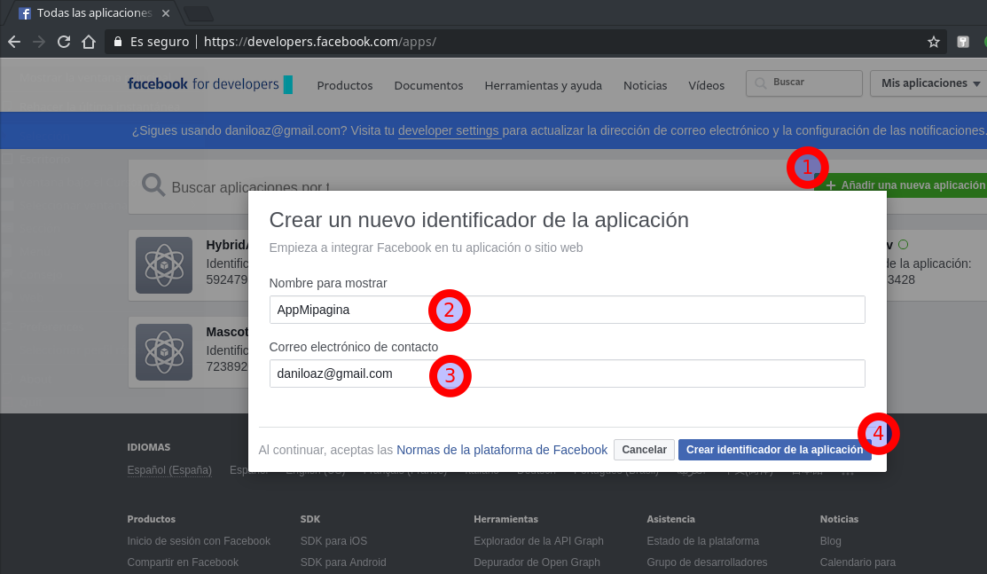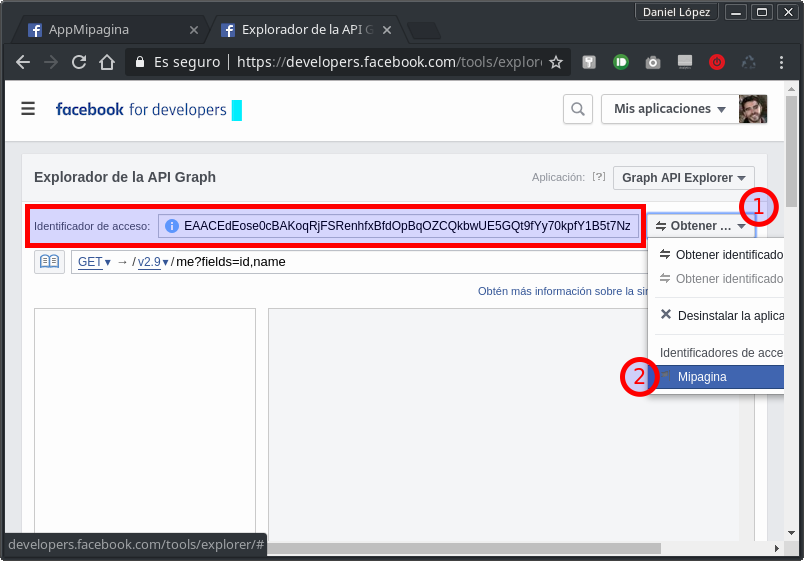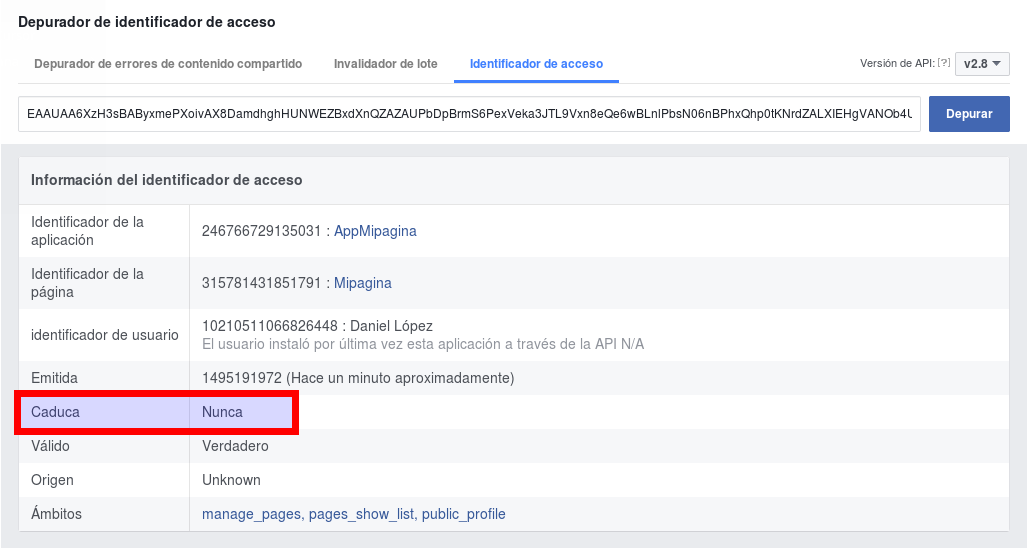 Through the following instructions you can easily get a permanent access_token to automatically connect your applications to a Facebook page and be able to obtain for example your number of followers periodically, get new likes or comments in real time, publish new entries in the timeline, or any of the possibilities offered by the Facebook Pages API.
Through the following instructions you can easily get a permanent access_token to automatically connect your applications to a Facebook page and be able to obtain for example your number of followers periodically, get new likes or comments in real time, publish new entries in the timeline, or any of the possibilities offered by the Facebook Pages API.
1. Get Facebook page identifier

How to get Facebook page identifier - Step 1

How to get Facebook page identifier - Step 2
2. Create a FB App for your page
2.1 Go to My apps.
2.2 Create new app, for example AppMipagina:

2.3 The previous step will take you to the administration page of your new App. There you will select the Configuration menu option and the data that we are interested in will be shown: the application identifier and its secret key , which you can only access by clicking on the Show button (#2 in the next screenshot). Do not forget to select the category «Applications for pages» (#3) and save changes:

3. Get short-lived access token
3.1 Go to Facebook API Graph Explorer.
3.2 Select the page for which you want to obtain the access token in the right-hand drop-down box, click on the Send button and copy the resulting access_token, which will be a short-lived token (2 hours).

4. Get long-lived access token
4.1 Enter the following URL in your browser’s address bar:
https://graph.facebook.com/v2.8/oauth/access_token?grant_type=fb_exchange_token&client_id=<strong>{app_id}</strong>&client_secret=<strong>{app_secret}</strong>&fb_exchange_token=<strong>{short_lived_token}
</strong>That in our example would look like this:
https://graph.facebook.com/v2.8/oauth/access_token?grant_type=fb_exchange_token&client_id=<strong>246766729135031</strong>&client_secret=<strong>7dc9596d6f58cf94bc9e3f6b48decc69</strong>&fb_exchange_token=<strong>EAACEdEose0cBAKPkEP5zf31S7cfbSXZBJEfNLsgZCZBv2q2laGOg2tipmGWHqnwZBICIZAAKK18UVGRK9AWjZAh4eRac8j9VEOfh7m9gZBOPZBXwOGTKyGMdZAnfbWqSbIufzgY2CPgzN45XCDhN9bsPh7I8bwNIvy0oHJh3rL35CcyyPWpI33R5Jknul2NLUpuHMZD
</strong>The result will be something like this:
{"access_token":"<strong>EAAUAA6XzH3sBAKty6EU2yZCEmKxJTqOzr3BF5F30ehZA8xxwoWluH6ETjIZAlAcGmtQM3xR4Q9alnzE9osu5kFarHB2avGHHFAMVI2Q0xF62PLeaV8PfrzaMa3YBqMs57a19noZB6s41ziqlbDUImoBWQVDlU3x1msVdsDqulaZsZD</strong>","token_type":"bearer","expires_in":5184000}The alphanumeric string «access_token», marked in bold, will be the long-lived access token we wanted to get, which, as the expires_in attribute indicates, expires 5,184,000 seconds after being generated, ie 2 months.
5. Get permanent access token
But even though a couple of months is a considerable time, it can be quite tedious to have to repeat this process every 2 months in order to renew access for your applications, so there is still one last step in order to get the permanent access_token that we were pursuing from the beginning, which will no longer be necessary to renew once generated.
So you will get to the following URL from your browser:
https://graph.facebook.com/<strong>{page_id}</strong>?fields=access_token&access_token=<strong>{long_lived_token}
</strong>That in our example would be:
https://graph.facebook.com/<strong>315781431851791</strong>?fields=access_token&access_token=<strong>EAAUAA6XzH3sBAKty6EU2yZCEmKxJTqOzr3BF5F30ehZA8xxwoWluH6ETjIZAlAcGmtQM3xR4Q9alnzE9osu5kFarHB2avGHHFAMVI2Q0xF62PLeaV8PfrzaMa3YBqMs57a19noZB6s41ziqlbDUImoBWQVDlU3x1msVdsDqulaZsZD</strong>The answer you get will look like this:
{
"access_token": "<strong>EAAUAA6XzH3sBAByxmePXoivAX8DamdhghHUNWEZBxdXnQZAZAUPbDpBrmS6PexVeka3JTL9Vxn8eQe6wBLnlPbsN06nBPhxQhp0tKNrdZALXIEHgVANOb4U2eIz3BRHqTCAjSoFxqVZBWjc9K3qHyyRcGczccU7NRWjj5OkzxbAZDZD</strong>",
"id": "315781431851791"
}And now, yes, this token linked to the Facebook page with the id that appears in the answer (315781431851791 in our example) is permanent.
6. Verify that the generated token is permanent
You can confirm the generated token is permanent using the Facebook Access Token Debugger:

If you find it more convenient, you can follow these same instructions through the following video:




Comments
Submit comment